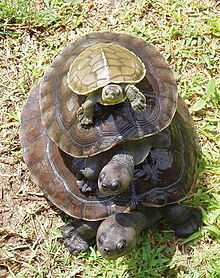Yellow pond turtle
| Yellow pond turtle |
| |
| Stuffed specimen of Mauremys mutica kami, exhibited in the National Museum of Nature and Science, Tokyo, Japan. |
| Conservation status |
| |
| Scientific classification |
| Kingdom: |
Animalia |
| Phylum: |
Chordata |
| Class: |
Sauropsida |
| Order: |
Testudines |
| Suborder: |
Cryptodira |
| Superfamily: |
Testudinoidea |
| Family: |
Geoemydidae |
| Subfamily: |
Geoemydinae |
| Genus: |
Mauremys |
| Species: |
M. mutica |
| Binomial name |
Mauremys mutica
(Cantor, 1842) |
|
| Synonyms[1] |
- Mauremys mutica mutica
- Emys muticus Cantor, 1842
- Emys mutica Gray, 1844
- Clemmys mutica Boettger, 1888
- Damonia mutica Boulenger, 1889
- Clemmys schmackeri Boettger, 1894
- Geoclemys mutica Siebenrock, 1909
- Cathaiemys mutica Lindholm, 1931
- Annamemys grochovskiae Tien, 1957
- Annamemys groeliovskiae Battersby, 1960 (ex errore)
- Mauremys mutica McDowell, 1964
- Mauremys muica Zhou & Zhou, 1991 (ex errore)
- Mauremys grochovskiae Iverson & McCord, 1994
- Mauremys mutica mutica Yasukawa, Ota & Iverson, 1996
- Cathaiemys mutica mutica Vetter, 2006
- Mauremys mutica kami
- Mauremys mutica kami Yasukawa, Ota & Iverson, 1996
- Mauremys mutica karni Ferri, 2002 (ex errore)
- Cathaiemys mutica kami Vetter, 2006
|
The yellow pond turtle (Mauremys mutica), is a species of turtle in the family Geoemydidae (formerly Bataguridae) found in China (Anhui, Zhejiang, Jiangsu, Fujian, Guangdong, Hainan, Guangxi, Yunnan etc.), Japan (introduced widely, and naturally in the Ryukyu archipelago), Taiwan, and northern and central Vietnam, and possibly adjacent Laos.
It is a parent of several hybrid Asian pond turtles that were described as new species. "Fujian pond turtles" ("Mauremys" iversoni) are hybrid specimens mainly produced in Chinese turtle farms, but possibly occasionally occurring in the wild as well, usually from matings between female Asian yellow pond turtles and golden coin turtles (Cuora trifasciata) males. The supposed "Mauremys" pritchardi turtles are wild and captive-bred hybrids between the present species and the Chinese pond turtle (Chinemys reevesi).[2]
One subspecies is currently recognized:
- Mauremys mutica kami (Yasukawa et al. 1996) – Ryukyu Archipelago of Japan.
Recent genetic studies[3] have shown that further subspecies might exist, especially in Vietnam and on Hainan.
These turtles are being threatened by unsustainable hunting for food and as pets; they are regularly available in Asian markets. Also, they are killed for use in folk medicine.[4] The IUCN considers M. mutica an endangered species.[5]
Notes
- ↑ Fritz Uwe; Peter Havaš (2007). "Checklist of Chelonians of the World". Vertebrate Zoology 57 (2): 231–232. ISSN 18640-5755. Archived from the original (PDF) on 2010-12-17. Retrieved 29 May 2012.
- ↑ Parham et al. (2001), Buskirk et al. (2005)
- ↑ Fong et al. (2007)
- ↑ da Nóbrega Alves et al. (2008)
- ↑ ATTWG (2000)
References
- Asian Turtle Trade Working Group (ATTWG) (2000). Mauremys mutica. 2006. IUCN Red List of Threatened Species. IUCN 2006. www.iucnredlist.org. Retrieved on 29 July 2007.
- Buskirk, James R.; Parham, James F. & Feldman, Chris R. (2005): On the hybridisation between two distantly related Asian turtles (Testudines: Sacalia × Mauremys). Salamandra 41: 21-26. PDF fulltext
- da Nóbrega Alves, Rômulo Romeu; da Silva Vieira; Washington Luiz & Gomes Santana, Gindomar (2008): Reptiles used in traditional folk medicine: conservation implications. Biodiversity and Conservation 17(8): 2037–2049. doi:10.1007/s10531-007-9305-0 (HTML abstract, PDF first page)
- Parham, James Ford; Simison, W. Brian; Kozak, Kenneth H.; Feldman, Chris R. & Shi, Haitao (2001): New Chinese turtles: endangered or invalid? A reassessment of two species using mitochondrial DNA, allozyme electrophoresis and known-locality specimens. Animal Conservation 4(4): 357–367. PDF fulltext Erratum: Animal Conservation 5(1): 86 HTML abstract
External links
|
|---|
| | | | Suborder | |
|---|
| | Cryptodira | | |
|---|
| | | Carettinae | |
|---|
| |
- Chelonia
- Eretmochelys
- Natator
|
|---|
|
|---|
| | |
|---|
|
|---|
| | |
|---|
| | |
|---|
| | |
|---|
|
|---|
| | Pleurodira | | | Chelinae | |
|---|
| Chelodininae | |
|---|
| Hydromedusinae | |
|---|
|
|---|
| | |
|---|
| | |
|---|
|
|---|
|
|---|
| |
|


